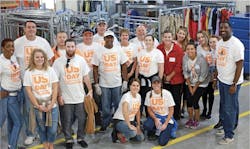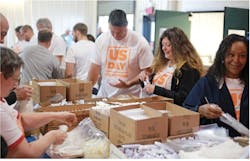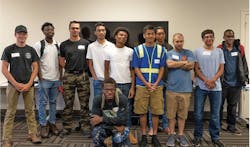2020 Builder of the Year: True Homes—a Culture Like No Other
Just about every company, institution, and organization claims to be exceptional, all about the “team,” and passionate about their mission, sometimes to the point where those claims are almost unbelievable. No one’s that good ... right?
But when True Homes co-founders Dan Horner and Mark Boyce use words like “having a heart for people,” to describe the North Carolina–based company they founded in 2007, they really mean it. And the proof of that statement, and others like it, is evident everywhere you look.
Employees say their company is a “family” with a “purpose-driven” mission—terms that skeptics may interpret as simply toeing the company line for their bosses. But they’re not.
True’s simple, concise vision is to provide people the opportunity for more life with a mission to be uniquely exceptional in how they relate to clients, associates, and trade partners. And it works.
Those statements, and the culture they represent, fuel an organization targeting 2,000 closings and $491.2 million in revenue in 2020, up 19% and 12%, respectively, from 2019 (and gross margins that have consistently exceeded 20% since 2008), which is even more impressive in a year of uncertainty.
“It’s not just a concept or a slogan,” Horner says. “We put real, meaningful effort and activity behind that, and it’s more of a life journey that people are on at True Homes.”
RELATED
- Great Company Culture Is a Talent Magnet
- 10 Ways to a Customer-Centric Culture
- Home Builder Company Culture Defined
- Leading the Way to Better Customer Service
Leadership on Display
Before launching True Homes, Horner and Boyce left CP Morgan, once Indianapolis’ market leader, and with partner Dave Cuthbertson spent a year planning to build a company that embraced the notion that all people have dignity. They believed creating a culture that exhibits true love and a focus on others would maximize whatever the organization set out to do. That purpose included creating close relationships among their employees but also with anyone who comes in contact with True Homes.
“True Homes’ leadership team is one of the most open, supportive, involved, and engaged we have found,” wrote Scott Sedam, president of TrueNorth Development, in a report following a visit to True Homes as an examiner for Pro Builder’s annual National Housing Quality (NHQ) awards program in 2018, for which the company won Gold. “Even in well-run companies, there is often a certain distance between senior leadership and those who do the day-to-day work of the company. We found no hint of that at True Homes.”
For closing manager Rosa White, it’s a regular routine. “Mark and Dan come to my desk, sit beside me, and treat me like I’m a founder as well,” says White, who has been with True Homes almost 14 years. “They work right alongside you and roll up their sleeves ... and you feel like we’re all in it together.”
Another way executive partners show a “heart for people” and win over employees is by providing an “opportunity for more life.” Every year, an executive team partner meets with each employee and, without bias or prompting, helps him or her develop a personal More Life Vision and map their journey to attain it.
For Lyncel Earley, senior HR manager, it was pursuing a professional certification. For estimator Jackie Fitzella, it was the company’s fourfold matching of her $250 donation to a nonprofit. Other examples include making more time for family and earning additional paid time off to recharge.
RELATED
And, if you consider some extra cash as affording an opportunity for more life, consider that every one of True’s 300-plus employees receives a bonus check from a reward program that pays $25 for every home True closes above its annual target, which was 1,600 this year; in other words, $10,000 each if the company’s 2020 forecast of 2,000 closings holds true.
All of which is to say, the culture works. Not just in producing sales, revenue, and profit (among traditional performance metrics), but also in extremely high employee satisfaction and extremely low turnover. Employees perceive themselves as part of the “Big P” or Big Purpose, working for a company that isn’t merely out for profit, but also (and more importantly) is having a positive impact on the community.
Those metrics are validated by Energage, an independent company measuring employee engagement, and The Charlotte Observer, which named True Homes “The Best Place to Work” out of 6,000 local companies in 2017, and every year since.
“When it all comes together ... when all of us are working in a synergistic fashion toward a common purpose and the fulfillment of that purpose, it is really magical,” Boyce says. “We have a tradition where we rise up to challenges and we lift up others as we progress ourselves.”
A New Model for Success
Boyce and Horner moved from Indiana to Monroe, N.C., just southeast of Charlotte, to launch True Homes during the beginning of the Great Recession. What they call their “synergistic structure” and “team of teams” approach encompasses three layers of organization. Each layer has defined roles and responsibilities to provide services for the rest of the company.
The Executive Services team, for instance, wears the owner and investor hats and provides corporate strategy, market research, and access to capital and land. Centralized Services consists of 12 teams that deliver support services to eight Market Teams, all of which develop their own annual plans, budgets, and tactical adjustments for tasks such as land delivery, selling, selecting, sourcing, and building.
True Homes evolved from simply surviving the downturn with 297 closings and $49.1 million in revenue in 2008 to 620 closings and $117 million by 2012. By then, True had started expanding into Raleigh, the Triad (Greensboro, Winston-Salem, and High Point), Wilmington (called the Coastal market), and Charleston, S.C., and had diversified its product offerings from first-time and first move-up to include second move-up, luxury, and active-adult segments. It later added townhomes and single-family infill.
As the company grew, the partners recognized the need to seek out and onboard new employees who aligned with the company culture. So they brought in Les Gleaves, an organizational development consultant who had coached executives at Walmart and directed a consultancy that developed values-based leadership. Gleaves recommended that True specifically document what it wanted from associates and managers by writing behavior-based definitions for desired traits, competencies, and character qualities.
One example is “exposing truth,” which is defined as full disclosure of the current truth and not withholding anything that may affect the client experience or team performance. A team characteristic for a leader, meanwhile, is the ability to simplify; a trait specifically defined as refining strategies, tactics, and processes down to the essence of the intended outcome using methods such as process mapping and facilitated conversations.
As they promoted more employees to managers, the founders realized they needed to provide professional leadership training, leading them to develop the True North Leadership methodology. The program describes expressions of leadership across 15 categories that associates should expect from their managers, which are either “right track” (in line) or “side track” (out of bounds) with True’s value-based culture. A “right track” behavior would be a leader who works with a team to address any issues that affect client or associate satisfaction. A “side track” behavior would be focusing on issues beyond the scope of a leader’s responsibilities and complaining about other things that need to be fixed before his or her department can meet its goals. Managers are rated quarterly on how well they fulfill those standards and develop annual plans for improving their leadership skills.
“If you really want to keep your culture moving and functioning, you have to do it through the leadership team,” says Gleaves, now the company’s executive partner for people. As a result, “Hiring leaders and training them became extremely important.”
Growing Pains
But operational execution and good intentions alone haven’t always been good enough. By 2015, True Homes was losing its client-centric focus, chasing volume while customer satisfaction scores declined. Sure, it was hitting financial and closing goals, making it relatively easy for some teams to overlook core disciplines and take shortcuts. An internal tug-of-war ensued between those who contended that their markets worked differently from others and those who held that the overall culture had to be consistent for all teams and markets companywide.
That year, the eight executive team members conducted what Gleaves dubbed a “come to Jesus meeting” off-site in a casual, comfortable setting. The sessions started with a lot of tension, arguing, and direct talk. But eventually the partners subordinated their egos and opinions and slowly began to support and listen to one another, he says. Through tears and apologies, the senior team ultimately recommitted to support a consistent culture across all divisions.
“We had some pretty big egos in the room, and we learned to submit those to a higher power to achieve what we’re trying to do,” Gleaves recalls. For any company that wants to go on this journey, he says, “Start with that meeting to be sure that you, yourselves, can walk the journey and actually do what you want people to do. If you can’t do it, it won’t be done.”
True strategically pivoted from riding market peaks to serving one client at a time ... in a drive to be “other-centric” and deliver on its new brand promise, “It’s all about U.”
As a result of that meeting of the minds, True strategically pivoted from riding market peaks to serving one client at a time. People Philosophies and Client Philosophies, platforms that guide the motivation behind how True Homes relates with clients, employees, and the trades, were initiated in a drive to be “other-centric” and deliver on its new brand promise, “It’s all about U.”
Since then, customer satisfaction metrics for sales, design studio, and personal builders, as measured by consultancy Woodland, O’Brien & Scott, reached top performer levels across market teams, and client willingness to refer has consistently been above 90%.
“We have an internal motto that we only build homes for friends and family members,” says Brad Crysler, market partner for field operations. “I tell my team to consider that they’re building my mom’s house. We are unique in that way; we put such an emphasis on the relationship.”
An Outside Perspective
True’s culture—and success—extends well beyond employees and customers. It touches trade and supply partners, lenders and mortgage brokers, local nonprofits serving veterans, and people seeking careers in home building in skilled trades and leadership roles.
Case in point: The 2018 NHQ judges’ feedback report revealed that most of True’s trade and supplier partners scouted whether a jobsite was ready for their crews or to make critical measurements on their own—a cost suck for subs and suppliers that undermines any builder’s ability to attract the best crews and on-time deliveries.
Not any more. True Homes has since established a mutual accountability and respect pact with its subcontractors that outlines what the builder will do to provide the best work environment. If a trade partner reports that a jobsite isn’t ready, for instance, True pays that contractor a small stipend.
It’s an approach that also breeds trust. “We can take them at their word that the house is ready, and they allowed us to help them define what job-ready was,” says Jamie Oliver, president of SouthEnd Exteriors, an exterior trim contractor in Charlotte, N.C.
This shared accountability pact, along with scheduling a steady stream of year-round work with a 90-day look ahead, partially explains why True Homes hasn’t been hindered by the tight availability of skilled labor, even as it grew to building more than 1,800 homes in roughly the same geographic footprint. In fact, many trades have been with True Homes since it began, and most have been partners for more than a decade (see “TED Talks … and Delivers,” below).
Another key to that success is applying a manufacturing mentality to home building by treating the construction site as a factory floor. “Our trade partners are accustomed to coming to our jobs because the work is predictable, like manufacturing. It’s easier and sustainable,” says Travis Deckert, supply chain market partner (essentially a purchasing manager in True’s nomenclature). ”We’re at the point where our trades are very culturally aligned.”
Supply chain partners like Deckert are embedded with field team managers, both acting as “plant managers” at construction sites. But they don’t just focus on schedule and transactional cost considerations for securing labor; they also train subcontractors and their crews—new and existing members—to align with the builder’s quality standards. At which point, those workers are certified as True Crews.
The managers also engage in relationship building by soliciting feedback and regular reviews to discuss capacity, competency, and cost concerns. Subcontractors pledge to consistently send True Crews and provide better pricing for True Homes jobs, and in return the builder delivers year-round work, mutual respect, and the conditions that enable the subs to be efficient and make a profit.
Holding Up in a Crisis
True Homes’ strategic pivot in 2015 was about growing and strengthening the roots of resilience—being an oak tree in a pine tree industry—to position the company for the next downturn. Little did the company (or anyone) count on a global pandemic, and its ripple effects, to get in the way.
When stay-at-home orders early in the pandemic curtailed construction across the country, trades and suppliers worried about their fates. Instead of sitting back, True’s executive team reached out to trade and supplier partners to help assuage those fears.
“Every time there was a hiccup or something bigger than a little bump, they were forthcoming with information and their plans to get us through it,” says Cindy Cooper, director of operations for JLF Construction Co., an interior trim contractor in Danville, Ind. “Wanting to make this about all of us versus just about them speaks to exactly what they’re about.”
And as the price of lumber escalated as fast as nationwide COVID-19 cases during the second and third quarters, Skip Norris, president of The Building Center, a Carolinas lumber and building products dealer, found he couldn’t raise his extended price quotes for lumber, trusses, and other products fast enough to cover rising costs. Instead of taking advantage of the situation, True Homes reached out to Norris asking what the company could do to help. They settled on shortening the guaranteed quote period to help defray Norris’ increasing expenses. “It’s not always about price,” Norris says. “If they’re successful, we’re successful, and they make that clear.”
The indelible takeaway for employees is not what they accomplished during the outbreak; it’s what their executive team partners did to demonstrate their love for one another.
Of course, that approach pervaded True Homes, as well. When the pandemic interrupted life and work, Deckert says the entire company moved as if it had the same heartbeat. What could have wiped out an entire second quarter of closings resulted in losing or delaying a couple dozen units … and no layoffs.
“It was never discussed that we might have layoffs,” says Connie DeBerry, senior financial analyst. “The focus was on how much business can we lose [and still] keep all our employees working here.”
And while employees were sequestered in “quarantine zones” at the office, they found a silver lining. “Many associates are displaced from teams, but we are still able to enjoy our work and the company,” says Christopher Ashley, operations partner for marketing. “We’ve become closer with those who aren’t necessarily on our own teams.”
The indelible takeaway for employees is not what they accomplished during the outbreak; it’s what their executive team partners did to demonstrate their love for one another.
“As soon as the pandemic happened, they were working with salespeople who have school-age children to [help them] figure out how to work from home and giving laptops to their kids. The executive team was just helping everybody they could,” DeBerry recalls. “This is just a phenomenal place. It truly is.”
TED Talks … and Delivers
True Homes has cultivated a tight and trustworthy relationship with its trade partners, becoming the builder of choice in a highly competitive market. Among the many benefits of achieving True Crew status, a rigorous certification process for subs, gaining access to True Homes’ Trade Efficiency Dashboard (TED) is arguably the most valuable to the builder and its trade partners.
TED is a proprietary portal that gives subcontractors access to daily schedules, follow-up schedules, variance notices, conformance data, and the Clean-Ready-Complete platform that reports job readiness, site cleanliness, job start, and completion.
But its most unique benefit debuted in January 2018, when True attached dollar figures for six months’ worth of dry runs and callbacks and attributed those costs across its 300 trade partners. A dry run or a callback can cost a sub as much as a couple hundred dollars, an expense they usually build into their bids to recoup.
With TED, that habit has been broken. Now subs can virtually see if the job is ready for them, and trust that it is, as well as evaluate the performance of their own crews. “They can look at the data and see if a crew has been dropping the ball and look into that,” says Marcus Wade, True Homes’ business intelligence analyst. “It’s a tool they can use to analyze their crews and the data related to True Homes jobs.”
"A dry run or a callback can cost a sub as much as a couple hundred dollars, an expense they usually build into their bids to recoup. With TED, that habit has been broken."
True piloted TED with about a dozen vendors two years ago. As of this September, about 120 trades were on the platform, able to look ahead at their workload and allocate more capacity to new projects.
In addition to helping its trade partners keep more money in their pockets, it also helped True Homes reduce hard costs by $1,000 per home by driving out inefficiencies. That, coupled with self-developing its land, enables the builder to pursue the first-time buyer niche, a market most competitors ignore or can’t afford to serve.
At price points starting under the $200s in some markets, True’s Integrity Collection provides first-time buyers a choice of open, traditional, transitional, or contemporary floor plans and lifestyle living options such as a guest bedroom, home office, or home gym. Buyers can customize plans further by removing or adding walls.
“We’re one of the few builders that offer choice at that price point, and we see that as a big, sustainable, competitive advantage that we don’t want to lose,” says Brad Crysler, market partner for field operations, and, in large part, it’s thanks to True’s Trade Efficiency Dashboard.
A True Calling to Do More
How or why would a home builder assign itself the task of fighting a societal problem like systemic intergenerational poverty? Because aligning employees with what Mark Boyce calls the “Big P purpose” is the strength of the True Homes organization. In 2011, “Out of a sense of gratitude and dependence on God’s provision,” Boyce says, True Homes started to divert a portion of its profits into the True Foundation, connecting with organizations that also share this purpose. It’s a big reason why True employees believe they are participating in something bigger than just working a job.
The True Foundation has ...
• Pledged to build 100 homes at cost for local organizations that provide housing for veterans, domestic abuse victims, refugees, and economically marginalized families, giving them the opportunity to accumulate wealth and economic mobility through homeownership.
• Founded Builders Bridge to develop a local pipeline for the next generation of skilled construction labor and opportunities to earn a living wage, including paid summer internships for high school students with True Homes and its trade partners.
• Partnered with the NAHB’s National Housing Endowment to fund and develop a residential construction management curriculum at North Carolina Agricultural and Technical State University (N.C. A&T), the nation’s largest historically black university. True also is considering donating lots for student-built housing projects that the builder will then buy from the university and resell to continue funding the program.
• Started and mentors an NAHB chapter at N.C. A&T. Students are exposed to the industry by attending the International Builders’ Show and participating in competitions.
• Provides $10,000 scholarships for women and minority students enrolled in construction management programs at schools in the Carolinas. The scholarships are given to 10 students annually.
• Established the True Homes Scholarship Fund two years ago through Wingate University. Any incoming student who lives in the Carolinas counties where True Homes builds is eligible to apply for the scholarship, which awards students $1,000 per year for up to four years.









